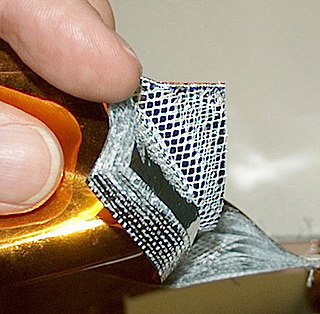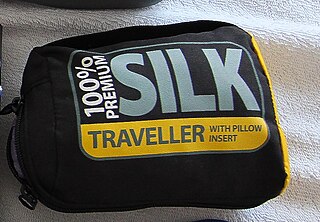 W
WA blanket is a piece of soft cloth large enough either to cover or to enfold a great portion of the user's body. It is usually used when a person goes to sleep or is otherwise at rest. It traps radiant bodily heat that otherwise would be lost through convection, helping to keep the user warm. Many children and adults use a blanket as a comfort object.
 W
WA thermal bridge, also called a cold bridge, heat bridge, or thermal bypass, is an area or component of an object which has higher thermal conductivity than the surrounding materials, creating a path of least resistance for heat transfer. Thermal bridges result in an overall reduction in thermal resistance of the object. The term is frequently discussed in the context of a building's thermal envelope where thermal bridges result in heat transfer into or out of conditioned space.
 W
WBuilding insulation is any object in a building used as insulation for any purpose. While the majority of insulation in buildings is for thermal purposes, the term also applies to acoustic insulation, fire insulation, and impact insulation. Often an insulation material will be chosen for its ability to perform several of these functions at once.
 W
WBuilding insulation materials are the building materials which form the thermal envelope of a building or otherwise reduce heat transfer.
 W
WInsulating glass (IG) consists of two or more glass window panes separated by a vacuum or gas-filled space to reduce heat transfer across a part of the building envelope. A window with insulating glass is commonly known as double glazing or a double-paned window, triple glazing or a triple-paned window, or quadruple glazing or a quadruple-paned window, depending upon how many panes of glass are used in its construction.
 W
WThe down of birds is a layer of fine feathers found under the tougher exterior feathers. Very young birds are clad only in down. Powder down is a specialized type of down found only in a few groups of birds. Down is a fine thermal insulator and padding, used in goods such as jackets, bedding (duvets), pillows and sleeping bags. The discovery of feathers trapped in ancient amber suggests that some species of dinosaur may have possessed down-like feathers.
 W
WA draught excluder is used to eliminate cold draught and slow heat loss. It is placed in the bottom crack of doors and windows.
 W
WGeofoam is expanded polystyrene (EPS) or extruded polystyrene (XPS) manufactured into large lightweight blocks. The blocks vary in size but are often 2 m × 0.75 m × 0.75 m. The primary function of geofoam is to provide a lightweight void fill below a highway, bridge approach, embankment or parking lot. EPS Geofoam minimizes settlement on underground utilities. Geofoam is also used in much broader applications, including lightweight fill, green roof fill, compressible inclusions, thermal insulation, and drainage.
 W
WInsulating glass (IG) consists of two or more glass window panes separated by a vacuum or gas-filled space to reduce heat transfer across a part of the building envelope. A window with insulating glass is commonly known as double glazing or a double-paned window, triple glazing or a triple-paned window, or quadruple glazing or a quadruple-paned window, depending upon how many panes of glass are used in its construction.
 W
WMulti-layer insulation (MLI) is thermal insulation composed of multiple layers of thin sheets and is often used on spacecraft and Cryogenics. Also referred to as superinsulation, MLI is one of the main items of the spacecraft thermal design, primarily intended to reduce heat loss by thermal radiation. In its basic form, it does not appreciably insulate against other thermal losses such as heat conduction or convection. It is therefore commonly used on satellites and other applications in vacuum where conduction and convection are much less significant and radiation dominates. MLI gives many satellites and other space probes the appearance of being covered with gold foil which is the effect of the amber-coloured Kapton layer deposited over the silver Aluminized mylar.
 W
W1,1,1,3,3-Pentafluoropropane (HFC-245fa) is a hydrofluorocarbon is a colorless gas used primarily for closed-cell spray foam insulation. HFC-245fa is also known as pentafluoropropane and by its chemical name 1,1,1,3,3-pentafluoropropane.
 W
WPipe Insulation is thermal or acoustic insulation used on pipework.
 W
WPolystyrene (PS) is a synthetic aromatic hydrocarbon polymer made from the monomer known as styrene. Polystyrene can be solid or foamed. General-purpose polystyrene is clear, hard, and rather brittle. It is an inexpensive resin per unit weight. It is a rather poor barrier to oxygen and water vapour and has a relatively low melting point. Polystyrene is one of the most widely used plastics, the scale of its production being several million tonnes per year. Polystyrene can be naturally transparent, but can be coloured with colourants. Uses include protective packaging, containers, lids, bottles, trays, tumblers, disposable cutlery and in the making of models.
 W
WPrimaLoft® is a brand of patented synthetic microfiber thermal insulation material that was developed for the United States Army in the 1980s. PrimaLoft is a registered trademark of PrimaLoft, Inc., the brand's parent company.
 W
WIn the context of building and construction, the R-value is a measure of how well a two-dimensional barrier, such as a layer of insulation, a window or a complete wall or ceiling, resists the conductive flow of heat. R-value is the temperature difference per unit of heat flux needed to sustain one unit of heat flux between the warmer surface and colder surface of a barrier under steady-state conditions.
 W
WA removable insulation blanket is a cover made from layers of thermal insulation materials that is fastened onto a mechanical component to maximize its efficiency, regulate its temperature, and improve workplace safety. Using such blankets ensures that the covered component is easily accessible and serviceable, unlike traditional stay-in-place insulation. Removable insulation blankets are also known as removable insulation pads, removable insulation covers, and removable insulation jackets.
 W
WA sleeping bag is an insulated covering for a person, essentially a lightweight quilt that can be closed with a zipper or similar means to form a tube, which functions as lightweight, portable bedding in situations where a person is sleeping outdoors. Its primary purpose is to provide warmth and thermal insulation through its synthetic or down insulation. It also typically has a water-resistant or water-repellent cover that protects, to some extent, against wind chill and light precipitation, but a tent is usually used in addition to a sleeping bag, as it performs those functions better. The bottom surface also provides some cushioning, but a sleeping pad or camp cot is usually used in addition for that purpose. The bottom surface of a sleeping bag may be moderately water repellent, but a plastic tarp or groundsheet is often used to protect against moist ground.
 W
WSleeping bag liners are lightweight cloth sacks usually fitted inside sleeping bags to provide extra comfort, insulation, and help keep the sleeping bag clean.
 W
WThermal insulation is the reduction of heat transfer between objects in thermal contact or in range of radiative influence. Thermal insulation can be achieved with specially engineered methods or processes, as well as with suitable object shapes and materials.
 W
WThermaSAVE is a panel building system which uses a 4 to 12-inch-thick core of expanded polystyrene sandwiched between two sheets of cellulose fiber-reinforced cement board varying in thickness from 3/8 to 7/16 inch, depending on structural requirements. This creates a "stress skinned" panel, also known as structural insulated panels (SIPs). Since c. 1984 H.H. "Hoot" Haddock from Florence, Alabama has been working on perfecting a polystyrene-based building system that would be faster and easier to construct than wood framed buildings, while having superior insulation and strength.
 W
WThinsulate is a brand of synthetic fiber thermal insulation used in clothing. The word is a portmanteau of the words thin and insulate, trademarked by 3M. The material is made by the 3M Corporation and was first sold in 1979. It was originally marketed as an inexpensive alternative to down; at the time, 3M claimed it was twice as warm as an equivalent amount of any natural material.